2012 Hyundai Sonata Hybrid service indicator
[x] Cancel search: service indicatorPage 14 of 403
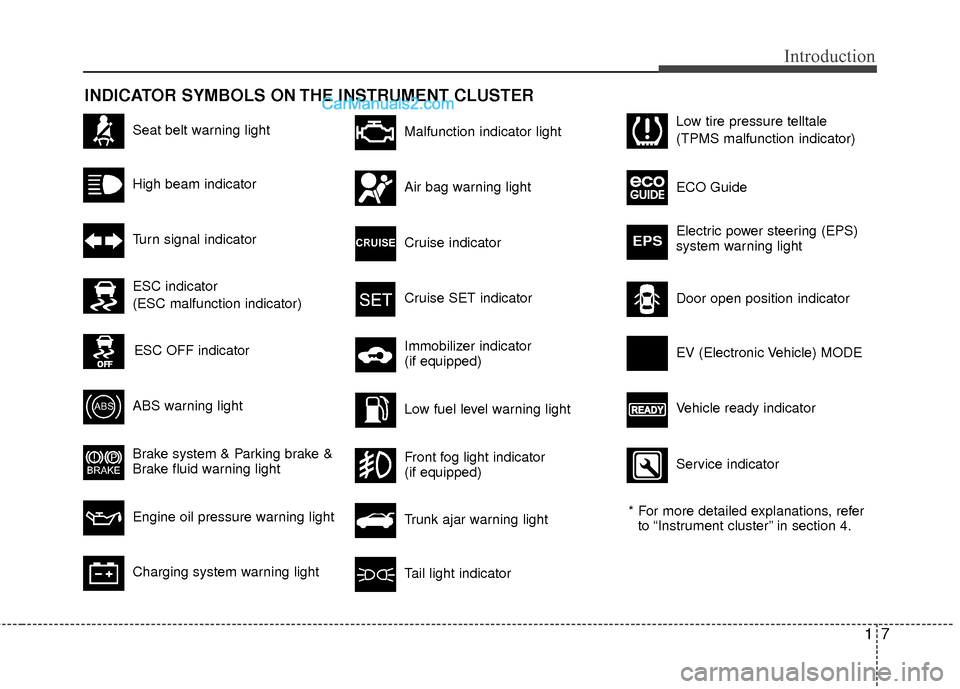
17
Introduction
INDICATOR SYMBOLS ON THE INSTRUMENT CLUSTER
Seat belt warning light
High beam indicator
Turn signal indicator
ABS warning light
Brake system & Parking brake &
Brake fluid warning light
Engine oil pressure warning light
Malfunction indicator light
Air bag warning light
Cruise indicator
Cruise SET indicator
Immobilizer indicator
(if equipped)
Low fuel level warning light* For more detailed explanations, referto “Instrument cluster” in section 4.
Charging system warning lightTail light indicator
Trunk ajar warning light
Front fog light indicator
(if equipped)
Door open position indicator Low tire pressure telltale
(TPMS malfunction indicator)
ECO Guide
Electric power steering (EPS)
system warning light
EPS
ESC indicator
(ESC malfunction indicator)
ESC OFF indicator
Vehicle ready indicator EV (Electronic Vehicle) MODE
Service indicator
Page 134 of 403

453
Features of your vehicle
Warnings and indicators
All warning lights are checked by turning
the engine start/stop button ON (do not
start the engine). Any light that does not
illuminate should be checked by an
authorized HYUNDAI dealer.
After starting the Hybrid system, check to
make sure that all warning lights are off.
If any are still on, this indicates a situa-
tion that needs attention. When releasing
the parking brake, the brake system
warning light should go off. The fuel
warning light will stay on if the fuel level
is low.
EV mode
This light illuminates if the vehicle only is
moved by the electric motor.
Service indicator
This indicator comes on when any mal-
function occurs in the hybrid system. If
this occurs, have your vehicle checked by
an authorized HYUNDAI dealer.
Air bag warning light
This warning light will illuminate for
approximately 6 seconds each time you
turn the engine start/stop button to the
ON position.
This light also comes on when the
Supplemental Restraint System (SRS) is
not working properly. If the SRS air bag
warning light does not come on, or
continuously remains on after operating
for about 6 seconds when you turned the
engine start/stop button to the ON posi-
tion or started the engine, or if it comes
on while driving, have the SRS inspected
by an authorized HYUNDAI dealer.
Page 148 of 403
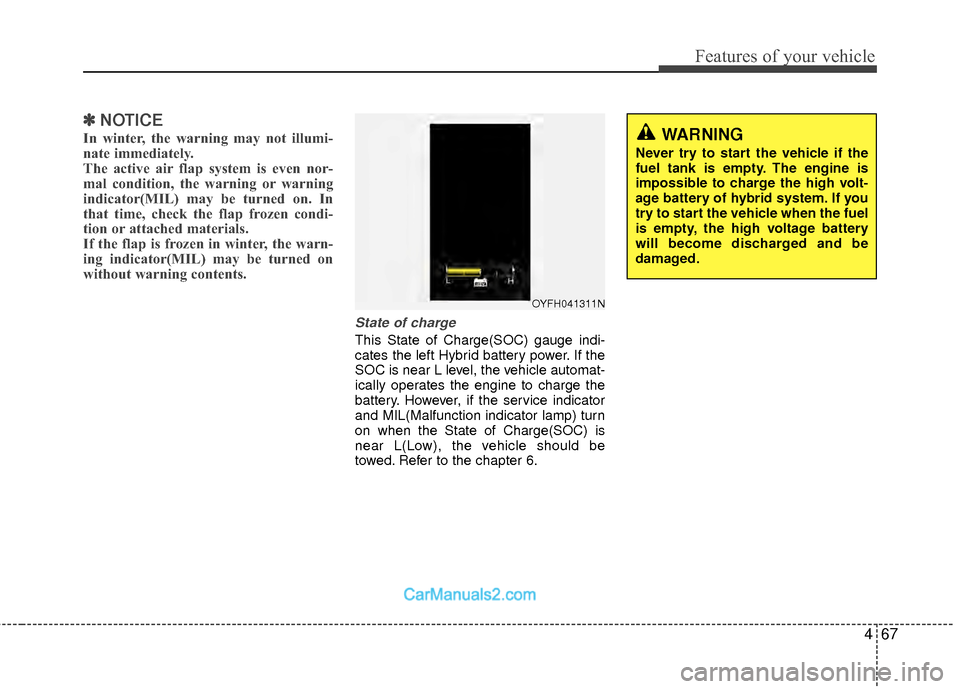
467
Features of your vehicle
✽
✽NOTICE
In winter, the warning may not illumi-
nate immediately.
The active air flap system is even nor-
mal condition, the warning or warning
indicator(MIL) may be turned on. In
that time, check the flap frozen condi-
tion or attached materials.
If the flap is frozen in winter, the warn-
ing indicator(MIL) may be turned on
without warning contents.
State of charge
This State of Charge(SOC) gauge indi-
cates the left Hybrid battery power. If the
SOC is near L level, the vehicle automat-
ically operates the engine to charge the
battery. However, if the service indicator
and MIL(Malfunction indicator lamp) turn
on when the State of Charge(SOC) is
near L(Low), the vehicle should be
towed. Refer to the chapter 6.
OYFH041311N
WARNING
Never try to start the vehicle if the
fuel tank is empty. The engine is
impossible to charge the high volt-
age battery of hybrid system. If you
try to start the vehicle when the fuel
is empty, the high voltage battery
will become discharged and be
damaged.
Page 238 of 403
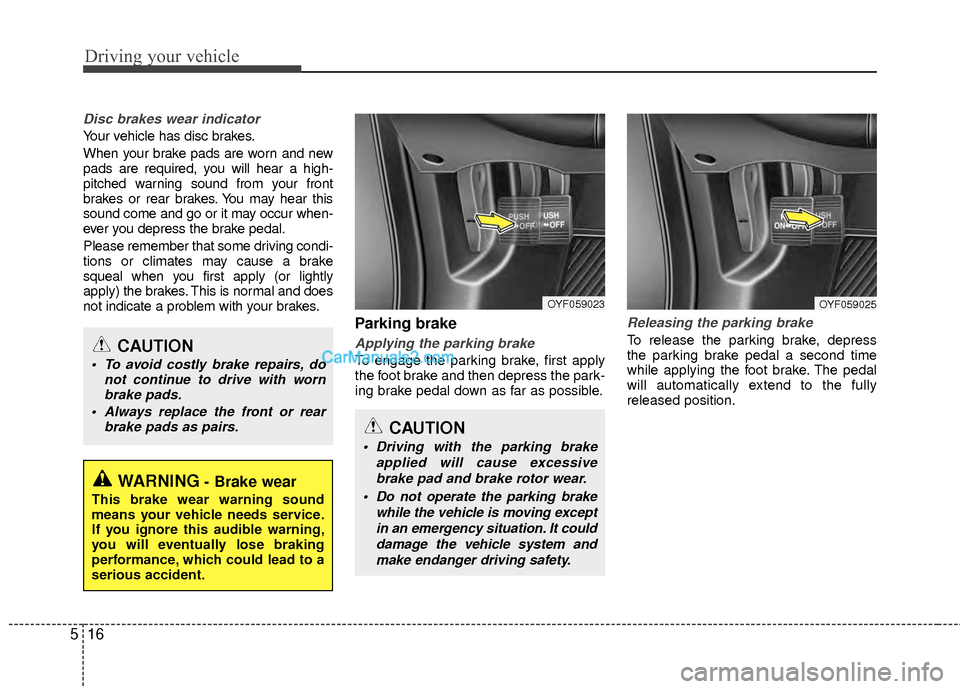
Driving your vehicle
16
5
Disc brakes wear indicator
Your vehicle has disc brakes.
When your brake pads are worn and new
pads are required, you will hear a high-
pitched warning sound from your front
brakes or rear brakes. You may hear this
sound come and go or it may occur when-
ever you depress the brake pedal.
Please remember that some driving condi-
tions or climates may cause a brake
squeal when you first apply (or lightly
apply) the brakes. This is normal and does
not indicate a problem with your brakes.
Parking brake
Applying the parking brake
To engage the parking brake, first apply
the foot brake and then depress the park-
ing brake pedal down as far as possible.
Releasing the parking brake
To release the parking brake, depress
the parking brake pedal a second time
while applying the foot brake. The pedal
will automatically extend to the fully
released position.
WARNING- Brake wear
This brake wear warning sound
means your vehicle needs service.
If you ignore this audible warning,
you will eventually lose braking
performance, which could lead to a
serious accident.
CAUTION
To avoid costly brake repairs, do
not continue to drive with wornbrake pads.
Always replace the front or rear brake pads as pairs.
OYF059023OYF059025
CAUTION
Driving with the parking brake
applied will cause excessivebrake pad and brake rotor wear.
Do not operate the parking brake while the vehicle is moving exceptin an emergency situation. It coulddamage the vehicle system andmake endanger driving safety.
Page 275 of 403
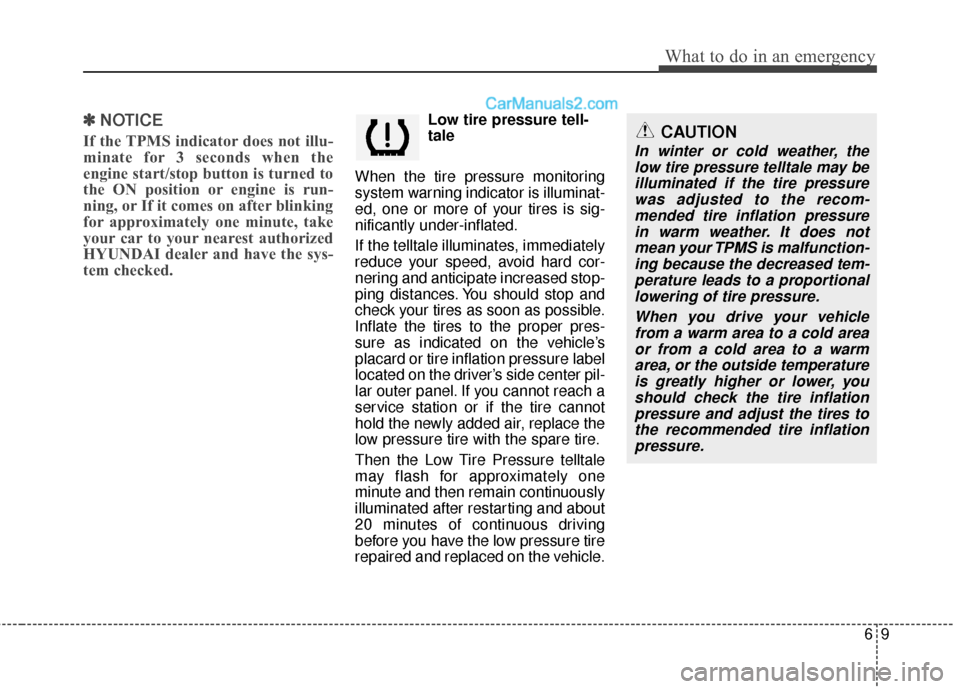
69
What to do in an emergency
✽
✽NOTICE
If the TPMS indicator does not illu-
minate for 3 seconds when the
engine start/stop button is turned to
the ON position or engine is run-
ning, or If it comes on after blinking
for approximately one minute, take
your car to your nearest authorized
HYUNDAI dealer and have the sys-
tem checked.
Low tire pressure tell-
tale
When the tire pressure monitoring
system warning indicator is illuminat-
ed, one or more of your tires is sig-
nificantly under-inflated.
If the telltale illuminates, immediately
reduce your speed, avoid hard cor-
nering and anticipate increased stop-
ping distances. You should stop and
check your tires as soon as possible.
Inflate the tires to the proper pres-
sure as indicated on the vehicle’s
placard or tire inflation pressure label
located on the driver’s side center pil-
lar outer panel. If you cannot reach a
service station or if the tire cannot
hold the newly added air, replace the
low pressure tire with the spare tire.
Then the Low Tire Pressure telltale
may flash for approximately one
minute and then remain continuously
illuminated after restarting and about
20 minutes of continuous driving
before you have the low pressure tire
repaired and replaced on the vehicle.CAUTION
In winter or cold weather, the low tire pressure telltale may beilluminated if the tire pressurewas adjusted to the recom-mended tire inflation pressurein warm weather. It does notmean your TPMS is malfunction-ing because the decreased tem-perature leads to a proportionallowering of tire pressure.
When you drive your vehiclefrom a warm area to a cold areaor from a cold area to a warmarea, or the outside temperatureis greatly higher or lower, youshould check the tire inflationpressure and adjust the tires tothe recommended tire inflationpressure.
Page 277 of 403
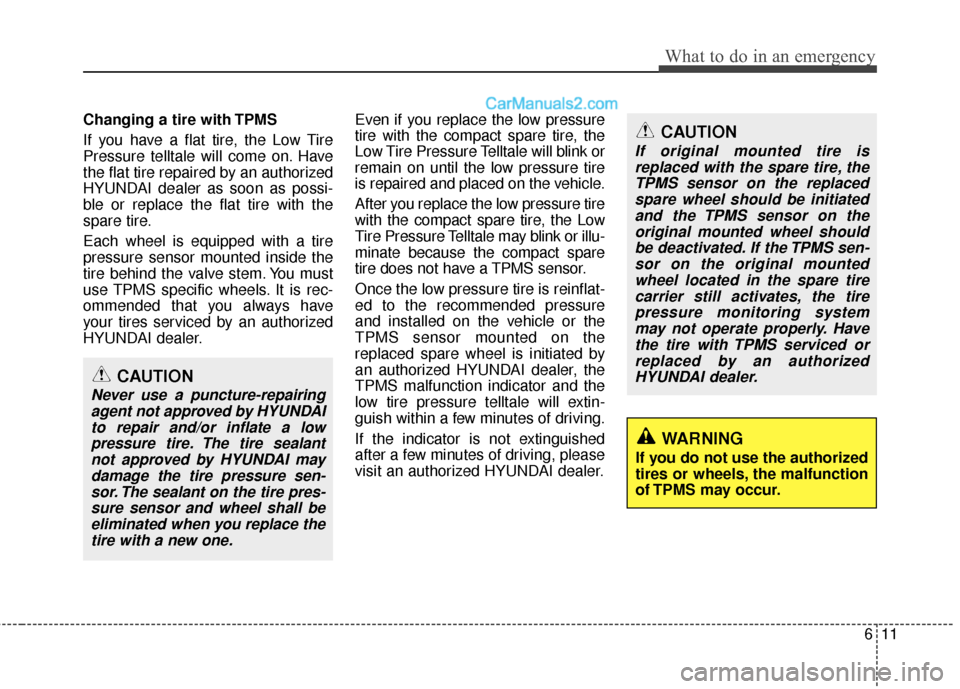
611
What to do in an emergency
Changing a tire with TPMS
If you have a flat tire, the Low Tire
Pressure telltale will come on. Have
the flat tire repaired by an authorized
HYUNDAI dealer as soon as possi-
ble or replace the flat tire with the
spare tire.
Each wheel is equipped with a tire
pressure sensor mounted inside the
tire behind the valve stem. You must
use TPMS specific wheels. It is rec-
ommended that you always have
your tires serviced by an authorized
HYUNDAI dealer.Even if you replace the low pressure
tire with the compact spare tire, the
Low Tire Pressure Telltale will blink or
remain on until the low pressure tire
is repaired and placed on the vehicle.
After you replace the low pressure tire
with the compact spare tire, the Low
Tire Pressure Telltale may blink or illu-
minate because the compact spare
tire does not have a TPMS sensor.
Once the low pressure tire is reinflat-
ed to the recommended pressure
and installed on the vehicle or the
TPMS sensor mounted on the
replaced spare wheel is initiated by
an authorized HYUNDAI dealer, the
TPMS malfunction indicator and the
low tire pressure telltale will extin-
guish within a few minutes of driving.
If the indicator is not extinguished
after a few minutes of driving, please
visit an authorized HYUNDAI dealer.CAUTION
If original mounted tire is
replaced with the spare tire, theTPMS sensor on the replacedspare wheel should be initiatedand the TPMS sensor on theoriginal mounted wheel shouldbe deactivated. If the TPMS sen-sor on the original mountedwheel located in the spare tirecarrier still activates, the tirepressure monitoring systemmay not operate properly. Havethe tire with TPMS serviced orreplaced by an authorizedHYUNDAI dealer.
CAUTION
Never use a puncture-repairingagent not approved by HYUNDAIto repair and/or inflate a lowpressure tire. The tire sealantnot approved by HYUNDAI maydamage the tire pressure sen-sor. The sealant on the tire pres-sure sensor and wheel shall beeliminated when you replace thetire with a new one.
WARNING
If you do not use the authorized
tires or wheels, the malfunction
of TPMS may occur.
Page 384 of 403
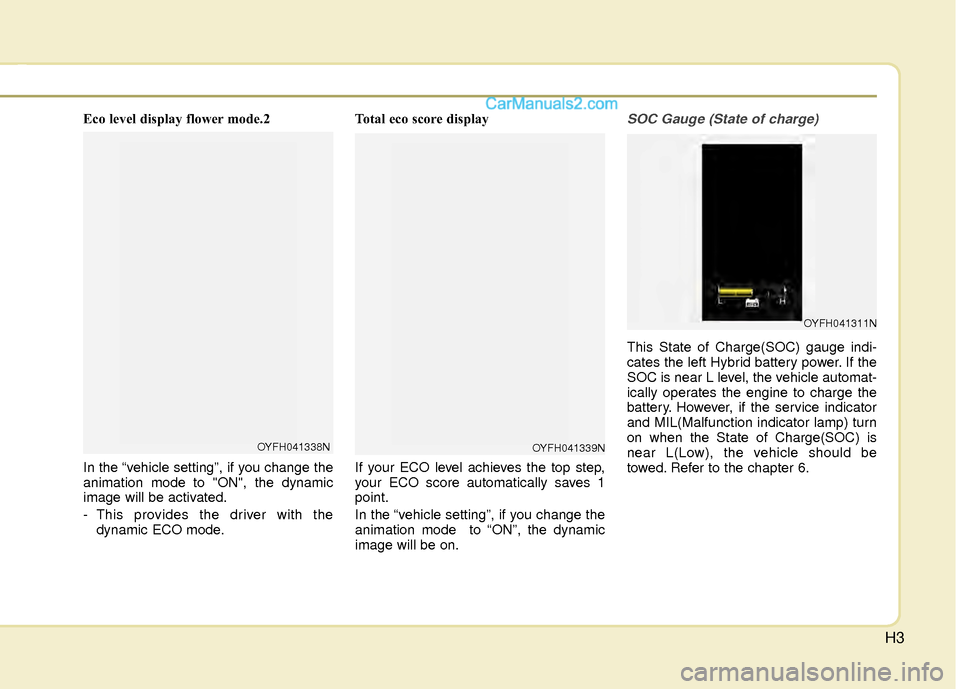
H3
Eco level display flower mode.2
In the “vehicle setting”, if you change the
animation mode to "ON", the dynamic
image will be activated.
- This provides the driver with thedynamic ECO mode. Total eco score display
If your ECO level achieves the top step,
your ECO score automatically saves 1
point.
In the “vehicle setting”, if you change the
animation mode to “ON”, the dynamic
image will be on.SOC Gauge (State of charge)
This State of Charge(SOC) gauge indi-
cates the left Hybrid battery power. If the
SOC is near L level, the vehicle automat-
ically operates the engine to charge the
battery. However, if the service indicator
and MIL(Malfunction indicator lamp) turn
on when the State of Charge(SOC) is
near L(Low), the vehicle should be
towed. Refer to the chapter 6.
OYFH041338NOYFH041339N
OYFH041311N
Page 399 of 403

I5
Index
GaugeEngine temperature gauge··················\
··················\
·····4-42
Fuel gauge ··················\
··················\
··················\
···········4-43
Glass antenna ··················\
··················\
··················\
·········4-111
Glove box··················\
··················\
··················\
···············4-105
Hazard warning flasher··················\
··················\
··············4-68
Hazardous driving conditions ··················\
··················\
····5-30
Headlight bulb replacement ··················\
··················\
·······7-60
Headrest ··················\
··················\
··················\
············3-7, 3-11
Highway driving ··················\
··················\
··················\
······5-33
Homelink mirror, see the Electric chromic mirror (ECM) with HomeLink system ··················\
··················\
·········4-31
Hood··················\
··················\
··················\
··················\
·······4-21
Horn ··················\
··················\
··················\
··················\
·······4-30
How to use this manual ··················\
··················\
···············1-2
Hybrid HMC Hybrid system··················\
··················\
················H2
State of charge (SOC) ··················\
··················\
··············H3
Sonata hev energy flow ··················\
··················\
··H4, 4-45
The componets of hybrid vehicle ··················\
··············H7
The air intake of hybrid battery ··················\
···············H12
The READY indicator··················\
··················\
···········4-41
The ECO level··················\
··················\
················H2, 4-47\
The EV MODE ··················\
··················\
··················\
···4-53 The service indicator ··················\
··················\
·············4-53
The ECO GUIDE ··················\
··················\
··················\
4-43
Hybrid electric vehicle··················\
··················\
···············4-45
Immobilizer system ··················\
··················\
··················\
···4-7
Indicator symbols on the instrument cluster ··················\
·1-7
Indicators and warnings ··················\
··················\
·············4-53
Inside rearview mirror ··················\
··················\
···············4-31
Instrument cluster ··················\
··················\
··················\
····4-40 Engine temperature gauge··················\
··················\
·····4-42
Fuel gauge ··················\
··················\
··················\
···········4-43
Hybrid electric vehicle ··················\
··················\
··········4-45
Instrument panel illumination ··················\
·················4-41\
Odometer ··················\
··················\
··················\
·············4-41
Speedometer ··················\
··················\
··················\
········4-42
Trip computer ··················\
··················\
··················\
······4-44
Warning and indicators ··················\
··················\
·········4-53
Instrument panel fuse··················\
··················\
·················7-51\
Instrument panel illumination··················\
··················\
····4-41
Instrument panel overview ··················\
··················\
··········2-3
Interior care··················\
··················\
··················\
··············7-73
Interior features··················\
··················\
··················\
······4-106 Aux, USB and iPod port ··················\
··················\
·····4-110
Clothes hanger··················\
··················\
··················\
···4-109
Cup holder ··················\
··················\
··················\
·········4-106
Digital clock ··················\
··················\
··················\
······4-108
Floor mat anchor(s) ··················\
··················\
·············4-109
G
I
H